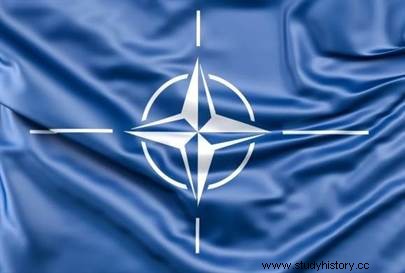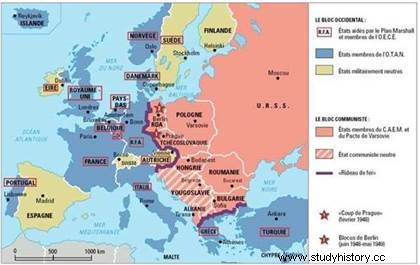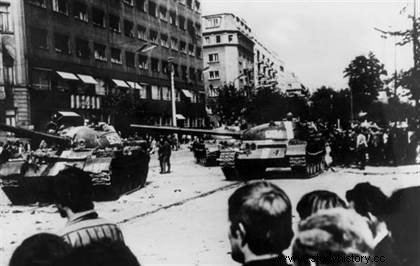 Created on May 14, 1955 in the midst of the Cold War, theWarsaw Pact is a military alliance that brings together the USSR, Poland, Albania, the GDR, Czechoslovakia, Bulgaria, Romania and Hungary. A counterpart of NATO, this pact is a response to the Paris Agreements (1954), which allow the rearmament of the Federal Republic of Germany (FRG) through its integration into the North Atlantic Treaty Organization. Designed for the defense of the Soviet bloc, its operation is quite revealing of the balance of power that structures the latter.
Created on May 14, 1955 in the midst of the Cold War, theWarsaw Pact is a military alliance that brings together the USSR, Poland, Albania, the GDR, Czechoslovakia, Bulgaria, Romania and Hungary. A counterpart of NATO, this pact is a response to the Paris Agreements (1954), which allow the rearmament of the Federal Republic of Germany (FRG) through its integration into the North Atlantic Treaty Organization. Designed for the defense of the Soviet bloc, its operation is quite revealing of the balance of power that structures the latter.
The Warsaw Pact
 The Warsaw Pact was a mutual defense treaty that placed the military forces of the signatory countries under a unified command, first assumed by Marshal Konev. The forces thus assembled could be evaluated, in 1955, at 6 million men; their armament was standardized. This military alliance also had a political impact:in Hungary in 1956, in Czechoslovakia in 1968, it justified the armed intervention of the U.S.S.R. to maintain, if necessary by force, the unity of the European communist bloc; Albania, which had aligned itself ideologically with the People's Republic of China, formally withdrew from the pact in September 1968. As early as 1955, Moscow had proposed to the West the simultaneous dissolution of N.A.T.O. and the Warsaw Pact Organization.
The Warsaw Pact was a mutual defense treaty that placed the military forces of the signatory countries under a unified command, first assumed by Marshal Konev. The forces thus assembled could be evaluated, in 1955, at 6 million men; their armament was standardized. This military alliance also had a political impact:in Hungary in 1956, in Czechoslovakia in 1968, it justified the armed intervention of the U.S.S.R. to maintain, if necessary by force, the unity of the European communist bloc; Albania, which had aligned itself ideologically with the People's Republic of China, formally withdrew from the pact in September 1968. As early as 1955, Moscow had proposed to the West the simultaneous dissolution of N.A.T.O. and the Warsaw Pact Organization.
Despite the appeasement of the Cold War and the development of nationalist currents in popular democracies, particularly in Romania, the Warsaw Pact continued to represent, in the early 1970s, a force of over 1.2 million men stationed in Eastern Europe. In July 1976, it was even going to strengthen its structures at the political level with the creation of a Committee of Foreign Ministers of the member countries of the pact.
An organ of repression
Within the system, the Soviet forces occupy a central place and have the best equipment, which they share in particular with their reputedly reliable allies, such as the Bulgarians. On the other hand, Moscow skilfully plays on national rivalries between Hungarians and Romanians, for example, to maintain its domination, even if it means weakening the coherence of this military structure. Leaving the pact is an extremely risky undertaking, as Budapest experienced during the 1956 Revolution. since in 1968 it was the troops of the Warsaw Pact who crushed the Prague Spring.
 However, this alliance constitutes the largest peacetime deployment of military forces in European history , since it will reach a total of nearly 150 Divisions (between the Urals and the Iron Curtain) at its peak. One can however doubt the loyalty of the units of some of its member states (East Germans, Poles, Hungarians, Czechoslovaks) in view of the speed with which this alliance will collapse.
However, this alliance constitutes the largest peacetime deployment of military forces in European history , since it will reach a total of nearly 150 Divisions (between the Urals and the Iron Curtain) at its peak. One can however doubt the loyalty of the units of some of its member states (East Germans, Poles, Hungarians, Czechoslovaks) in view of the speed with which this alliance will collapse.
The end of the Warsaw Pact
At the end of 1988, under the impulse of Gorbachev, the Soviet Union decided to grant the freedom of choice of their alliances to the members of the Pact. In 1990, Czechoslovakia and Hungary signed agreements with the USSR providing for the withdrawal of Soviet troops from their territories. The leaders of the member countries meet on June 7 in Moscow to transform the alliance into an "agreement based on a democratic basis, between sovereign states and equal rights".
The German Democratic Republic, because of its unification with the FRG, is the first to actually leave the pact (September 24, 1990). By a meeting of February 25, 1991 in Budapest, the Ministers of Foreign Affairs of the States which were still members dissolved the military structure of the pact; its political structure is in turn in July 1991. In 1991 only the very pro-Soviet Bulgaria was still part of it.
It is also interesting to note that in 1999, less than 10 years after the end of the Socialist Bloc, Warsaw, like Prague and Budapest, had joined NATO. For the inhabitants of these capitals of Eastern Europe, had the danger never stopped being perceived as coming from the east?
Bibliography
- The Warsaw Pact, by Claude Delmas. PUF, 1981.
